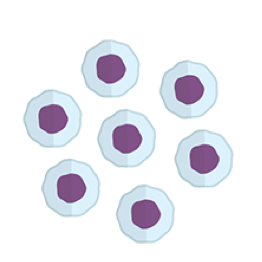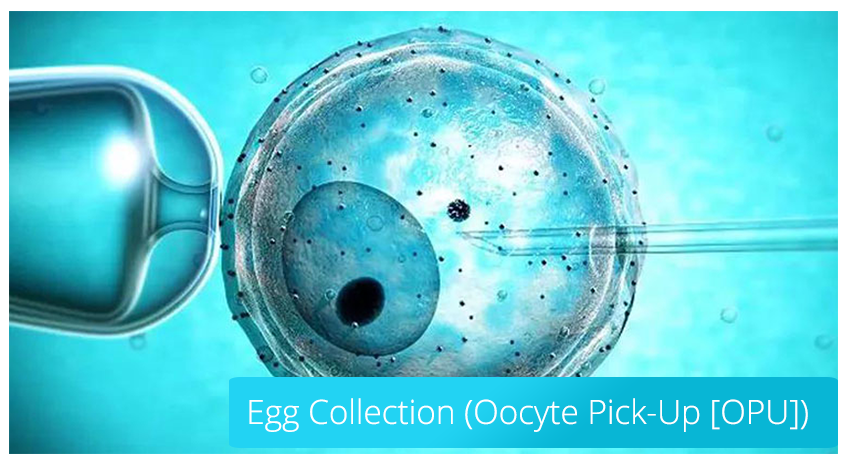Egg Collection in IVF Treatment
What is Egg Collection (OPU)?
Egg collection is a simple surgical procedure performed with vaginal aspiration in accompany of ultrasound. Egg pick-up process is performed under general anesthesia (sedation anesthesia) at our center. The vagina is entered by ultrasound probe to identify mature follicles then the follicle is entered by a needle. The eggs are then aspirated by needle attached to a pump unit from follicles. Egg collection process is usually completed in 10-20 minutes. Some patients might experience cramp-like pains on the day of process but it will subside the following day. Feeling swollen and/or compressed might continue for a few weeks after the procedure because the state of grown eggs continues in that period.
Higher egg yield points to more successful IVF
Does age matter with egg retrieval and IVF?
The recent study also found that to get one or two chromosomally normal embryos, fertility specialists need to retrieve between five and 14 eggs for women of around age 34. But that number rises to between 10 and 34 for 38-year-old women.
So, with older women, the more eggs the better the chance of a healthy, successful pregnancy.
We do also know that between 20 percent and 50 percent of embryos continue to develop to day five and that this percentage is dependent on the woman’s age, so unfortunately as with any fertility issue age does matter.
The Egg Retrieval Process

The egg retrieval is a 15-minute surgical procedure. No cuts, no stitches.
The word “surgery” might seem scary, but the egg retrieval process is quick and essentially painless. Here’s what you can expect before, during, and after the procedure.
This means getting eggs from a female body. The procedure is usually under anesthesia but does not require boarding. No pain is felt by the medications taken during the procedure. The procedure is performed with the help of a transvaginal needle and ultrasound used by the IVF doctor and the ovaries are reached. During the follow-up of the egg development, on the day it is determined that a sufficient number of eggs have matured, the eggs are injected to complete the last stage of development.
Egg collection is scheduled for 36 hours after this last drug injection.
During the collection of the eggs, sedatives, sleeping drugs can be given or the procedure can be performed under full anesthesia.
The procedure is similar to vaginal ultrasonography performed during your egg developmental follow-up. The only difference is that a needle attached to the vaginal ultrasound device passes through the vagina and collects the eggs inside your ovaries.
The average duration of the procedure is 30 minutes. Fertilization with sperm cells is carried out on the day the eggs are collected. After 2-3 hours of rest after the collection of eggs , the couple is discharged from the hospital.
After this stage of in vitro fertilization, double information is given about the drugs to be used.
Egg collection(OPU)
Eggs should be collected approximately 36 hours after the iğne cracking needle uygulan applied when it reaches a certain size. All eggs are collected by the method called U OPU (oocyte pick-up)..
Egg total operation is performed with the help of a special cannula added to the vaginal ultrasound probe. When the ultrasound probe is applied to the vagina, the eggs are entered one by one with the cannula advanced through the special tunnel and the contents are aspirated. Processing time varies between 15-20 minutes.
Egg collection can be performed under general or local anesthesia, depending on the patient. In local anesthesia, pain sensation is reduced with injections applied to the cervix. Patients undergoing general anesthesia should discontinue oral feeding six hours before the procedure.
The collected eggs are delivered to the embryology laboratory in the operating room. Embryologists examine the collected eggs under microscope and protect them in special liquids.
Egg collection is a low-risk surgery. Patients may experience minor pain and bleeding after the procedure. Generally, pain can be completely relieved with painkillers, while bleeding will disappear completely within a few days.
Egg Collection Process for IVF Treatment (oocyte pick up-OPU)
Almost all egg collection procedures are performed by vaginal ultrasonography (transvaginal ultrasonography).
Other methods of intervention are laparoscopy or transabdominal ultrasonography, which is rarely necessary.
In the transvaginal method, the ovaries are imaged with an ultrasound probe inserted into the vagina.
Before egg collection process:
Please take your Pregnyl or Ovitrel injection on the day and time you are told.
You do not need to go to the clinic the day after the injection.
You should not eat or drink anything from 24.00 on the night before the operation. (This includes small amounts of water, gum and cigarettes.)
Do not drive on the day of operation.
Be at your clinic 30 minutes before the scheduled appointment.
Before anesthesia, rings, necklaces, etc. should be removed and your valuable items such as credit card, money, deliver it to your relatives.
You must have an adult on the day of the procedure.
The dosage and timing of the drug to be administered for the final maturation of the eggs is very important. An inaccuracy can lead to no egg collection during egg collection.
If you have a medication that you use continuously, use it as the anesthetist says.
Tell your anesthesiologist if you have a febrile illness.
Just before the operation
• Go to the toilet and empty your bladder
• Remove dentures
• If you have a lens, remove it
• Remove watches and jewelery
• Remove makeup and nail polish
Operation room
• A catheter will be placed in your vein and any medication will be given in this way.
• A special device will monitor your heart and lung function throughout the operation
After the operation
• You will rest until you recover. You can leave the clinic after you have been given the necessary information about what to do after the procedure.
12 hours postoperatively
• Do not drive!
• Do not drink alcohol!
• Avoid activities that require attention
At home
• Get someone to help you
• If you have pain, you can use Paracetamol-derived painkillers.
• Call your doctor in case of excessive pain, fever, nausea, vomiting.
Egg quality over quantity or more is more
During the IVF cycle, one of the perennial questions asked is, how many eggs is enough? Does more compromise quality or is it really a “more is more” situation? And what is the ideal amount of eggs retrieved during the oocyte pick up (OPU) stage for a successful pregnancy?
This is a debate had by many fertility experts, with many saying that quality is more important than quality. After all, what matters is the eggs that go on to be fertilised embryos and keep growing to day five, when they are typically frozen or transferred to the uterus. But there’s growing research showing quantity is important.
What is premature ovulation (“premature ovulation”)?
GnRH analogs are used to prevent follicles from cracking before expected. Rarely, however, they may fail to do so, as follicles crack before the egg collection and the eggs are dispersed in the abdominal cavity. This event is called premature ovulation (premature ovulation).
In the case of premature ovulation, in vitro fertilization is canceled. However, if the sperm parameters are good, vaccination can be done.
Things to do after egg collection:
You may have pain and a small amount of vaginal bleeding in your groin after egg collection. It’s normal. You can use paracetamol derivatives for your pain
Drugs used in egg collection can make you feel dizzy and tired, and this effect can last all day long. For this reason, today do not require jobs (such as driving) do not do
Spend the day resting after the egg collection process, do not do heavy and tiring work
After discharge from the operation, a special diet is not required. You can eat and drink everything. Do not use alcohol.
You can take a shower at any time
Under what conditions and when should the treatment process be performed?
The fluid in the follicles is aspirated by means of a needle that passes through the vaginal wall and is advanced into the ovary.
The egg that comes with this liquid is collected under a microscope. This usually takes less than 30 minutes.
Various medications are used to help patients relax during the procedure. One of the two types of anesthesia described below is suitable for the patient:
Conscious sedation and local anesthesia
In this method, drugs such as “fentanyl and dormicum” are administered intravenously to the patient. Thus, the patient is provided with a light sleepiness, while the feeling of discomfort during the procedure is minimized. The patient may be aware of the environment and the procedure performed. There may also be personal differences in response to sedation.
General anesthesia
It is administered using intravenous general anesthetic drugs, which is a type of general anesthesia. The patient is in full sleep and is unaware of what is happening around him. In this type of anesthesia, it is generally not necessary to insert a tube into the airway (intubation) to ensure respiration. This is performed by an anesthesiologist.
Giving Sperm Sample
On the day the eggs are collected, you will need to give a sperm sample to the andrology laboratory by masturbating in a special toilet for use in fertilization.
Although almost all IVF centers have özel special rooms amacıyla to enable men to give sperm through masturbation, this is a troublesome task for many men.
If you have a previously frozen sperm sample, the procedure will be different.
The sperm cells in the sperm sample to be used in the fertilization process in the laboratory are separated by various methods. The ones that move better are selected and purified from seminal fluids.
Incubation and fertilization of oocytes
The collected eggs are evaluated under a microscope, each of which is graded according to maturity. The maturity of the egg determines its fertilization capacity. Then, insemination is performed according to the method decided to be applied.


![Egg Collection Process for IVF Treatment (Oocyte Pick-Up [OPU])](https://profdrmuratarslan.com.tr/en/wp-content/uploads/2019/06/oocyte-pick-up-OPU-740x416.png)
Add Your Comment